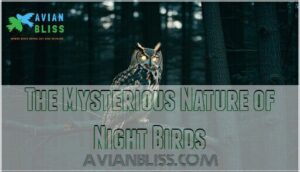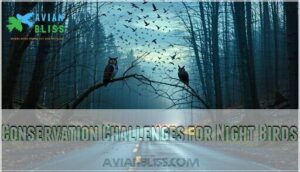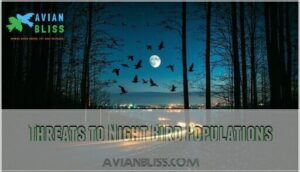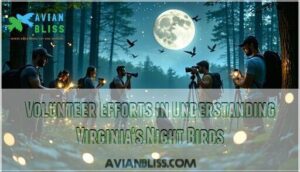This site is supported by our readers. We may earn a commission, at no cost to you, if you purchase through links.

Great Horned Owls silently patrol neighborhoods while Barred Owls call "who-cooks-for-you" from wooded areas.
Chuck-will’s-widows and Eastern Whip-poor-wills create the soundtrack of summer nights with their repetitive calls.
Northern Mockingbirds surprisingly sing at midnight near streetlights, showing off their vocal repertoire.
Black-crowned Night-Herons stalk fish in wetlands, and Common Nighthawks dive through the air catching insects.
These nocturnal species have evolved remarkable adaptations—from silent flight feathers to enhanced hearing—that make them masters of the night.
Each species offers unique identification clues that’ll help you solve those mysterious 2 AM wake-up calls, and understand the behaviors of these fascinating night birds.
Table Of Contents
- Key Takeaways
- Types of Night Birds in Virginia
- Nocturnal Bird Species in Virginia
- Owls in Virginia
- Sounds of Night Birds in Virginia
- The Mysterious Nature of Night Birds
- Conservation Challenges for Night Birds
- Threats to Night Bird Populations
- Studying Nocturnal Owl Species
- Volunteer Efforts in Understanding Virginia’s Night Birds
- Frequently Asked Questions (FAQs)
- What birds come out at night in Virginia?
- Why do I hear birds at 2am?
- What kind of bird makes noise at night?
- What birds are active at night?
- What time do night birds become most active?
- How do night birds navigate in complete darkness?
- Where can I best observe night birds safely?
- Do night birds migrate differently than daytime species?
- What equipment helps identify night birds effectively?
- Conclusion
Key Takeaways
- You’ll encounter seven distinct nocturnal bird species in Virginia, including five owl species (Great Horned, Barn, Barred, Short-eared, and Eastern Screech-Owl) plus nightjars like Chuck-will’s-widow and Eastern Whip-poor-will that create the soundtrack of summer nights.
- You can identify these birds by their unique calls—Barred Owls say "who-cooks-for-you," Eastern Whip-poor-wills repeat their three-note namesake call up to 400 times per hour, and Northern Mockingbirds surprisingly sing complex melodies at midnight near streetlights.
- You’ll find these birds are perfectly adapted for darkness with specialized features like silent flight feathers, asymmetrical ears for pinpoint hearing, enhanced night vision, and wide mouths for catching insects mid-flight.
- You can help protect Virginia’s night birds by reducing outdoor lighting during migration seasons, supporting habitat conservation efforts, and participating in citizen science projects like the Virginia Nightjar Survey or local Owl Prowl events.
Types of Night Birds in Virginia
Virginia’s night sky comes alive with an impressive variety of nocturnal birds, each perfectly adapted for life after dark.
You’ll discover that these mysterious creatures fall into several distinct categories that make nocturnal bird ID both fascinating and manageable.
The nightjar families include species like whip-poor-wills and chuck-will’s-widows, whose haunting bird call sounds echo through Virginia’s forests.
These insect hunters have evolved specialized wing structures for silent flight and wide mouths for catching prey mid-air.
Night heron types, including black-crowned and yellow-crowned varieties, patrol Virginia’s waterways with patience that’d make a chess master jealous.
Their long necks and sharp beaks make them formidable fish hunters.
Virginia’s owl species represent the ultimate nocturnal predators.
From tiny screech owls to massive great horned owls, these raptors showcase remarkable owl characteristics like asymmetrical ear placement for pinpoint hearing and specially designed feathers for silent swooping.
Understanding these categories helps you appreciate how each night bird species has carved out its unique ecological niche in Virginia’s diverse landscapes.
Nocturnal Bird Species in Virginia
Virginia’s nocturnal bird species represent a diverse group of hunters that you’ll encounter across the state’s varied habitats, from coastal marshes to dense woodlands.
Virginia’s night skies harbor secretive hunters perfectly adapted for darkness, each species claiming its unique ecological niche.
These seven remarkable species have adapted specialized hunting techniques and unique calls that make them perfectly suited for life in the darkness, offering you fascinating opportunities to observe nature’s nighttime activity, particularly in terms of their nocturnal behavior.
Northern Mockingbird
Northern Mockingbird’s nocturnal singing transforms Virginia’s nights into natural concerts.
You’ll hear young males belting out their mimicry behavior between midnight and 4 AM, showcasing remarkable urban adaptation skills.
- Nocturnal Singing: Males perform extended concerts during breeding season
- Mimicry Behavior: Copies sounds from frogs, insects, and other Virginia birds
- Diet Composition: Hunts insects attracted to streetlights and porch lights
- Urban Adaptation: Thrives in cities, using artificial lighting for nighttime foraging
Yellow-breasted Chat
You’ll encounter this secretive songbird skulking through dense tangles and overgrown fields during Virginia’s summer months.
The yellowbreasted chat’s repertoire includes an amazing variety of whistles, clicks, and chatters that echo through the darkness.
These Virginia birds prefer thick undergrowth where they hunt insects and berries.
Their night bird sounds create quite a concert from May through August before they migrate south.
| Aspect | Details | Notes |
|---|---|---|
| Chat Habitat | Dense thickets, brushy areas | Prefers early succession habitat |
| Chat Diet | Insects, spiders, berries | Forages in thick vegetation |
| Chat Migration | May-August in Virginia | Returns to Central America |
| Chat Vocalizations | Whistles, clicks, chatters | Most active at dawn/dusk |
| Chat Conservation | 37% population decline | Habitat loss main threat |
Common Nighthawk
You’ll spot Common Nighthawks swooping through twilight skies, their distinctive white wing patches flashing as they chase flying insects.
These nightjars aren’t actually hawks—they’re insectivorous birds that hunt moths, beetles, and mosquitoes during their evening feeding frenzies.
Their mottled brown and gray camouflage makes them nearly invisible when roosting on tree branches or gravel rooftops during daylight hours.
Common Nighthawk decline has been dramatic, with populations dropping over 50% since 1970.
During Virginia’s breeding season, you might hear their nasal "peent" calls or witness males performing spectacular diving displays.
Their migration patterns take them from Canada to South America, making Virginia an important stopover point for these remarkable nocturnal birds, with distinctive features and nocturnal habits.
Chuck-will’s-widow
Following the Common Nighthawk’s aerial acrobatics, you’ll encounter North America’s largest nightjar prowling Virginia’s forests.
The Chuck-will’s-widow dominates summer nights with its distinctive three-syllable call that inspired its name.
- Impressive size – Nearly 12 inches long with cryptic brown plumage
- Habitat preferences – Dense deciduous and mixed woodlands throughout Virginia
- Insect diet – Catches moths, beetles, and flying ants with wide gaping mouth
This member of the nightjar family arrives during breeding season from April through September. Chuckwillswidow populations remain stable compared to other declining nocturnal birds in Virginia.
You’ll hear their rhythmic calls echoing through oak and hickory forests, especially on warm humid nights. These skilled hunters use exceptional night vision to snatch insects mid-flight, playing a vital role in controlling pest populations across the Commonwealth’s wooded landscapes.
Eastern Whip-poor-will
While Chuck-will’s-widow commands attention with its size, the Eastern Whippoorwill captivates with its relentless call. You’ll hear this nightjar’s distinctive "whip-poor-WILL" echoing up to 400 times per hour during peak activity.
These nocturnal birds prefer Virginia’s pine barrens and oak woodlands, where their mottled brown plumage provides perfect camouflage. Eastern Whippoorwills catch moths and beetles during short aerial sallies, contributing to natural pest control.
| Behavior | Timing | Location |
|---|---|---|
| Calling | Dusk to dawn | Territory boundaries |
| Hunting | Night flights | Open woodland edges |
| Roosting | Daylight hours | Ground in leaf litter |
However, their populations face serious challenges from habitat loss and insect decline, dropping 75% over five decades. Conservation efforts now focus on protecting their breeding grounds, as these Virginia birds represent key indicators of ecosystem health among nocturnal species.
Black-crowned Night-Heron
You’ll find Black-crowned Night-Herons hunting silently through Virginia’s coastal habitat and wetland habitats year-round.
Watch for their ghostly silhouettes stalking through moonlit marshes with prehistoric patience.
These nocturnal birds demonstrate remarkable nocturnal hunting skills, using stealth to catch fish, frogs, and crustaceans after sunset.
Their diet analysis reveals opportunistic feeding patterns. While heron migration occurs seasonally elsewhere, Virginia’s populations remain stable.
Conservation status remains secure when their wetland habitats stay protected from development pressures, ensuring a stable environment for these nocturnal birds.
Yellow-crowned Night-Heron
Unlike the Black-crowned Night-Heron, you’ll encounter Yellow-crowned Night-Herons targeting crabs in Virginia’s coastal wetland habitats.
Their dietary habits focus heavily on crustaceans, especially during breeding season from March through November.
Migration patterns bring these nocturnal birds to saltmarshes and mangroves, where their habitat preference supports stable conservation status among Virginia’s night bird species.
These herons adjust their schedules based on fiddler crab emergence.
Owls in Virginia
You’ll find five distinct owl species hunting across Virginia’s diverse landscapes, from the tiny Eastern Screech-Owl in your backyard to the powerful Great Horned Owl in deep forests.
These silent predators use specialized feathers, asymmetrical ears, and razor-sharp talons to catch prey in complete darkness, making them perfectly adapted nocturnal hunters.
Great Horned Owl
Virginia’s most formidable nocturnal predator, the Great Horned Owl, dominates nighttime hunting across the state.
You’ll recognize this powerful raptor by its distinctive ear tufts and piercing yellow eyes. These owl species adapt to diverse habitats, from dense forests to suburban neighborhoods, making them among Virginia’s most widespread raptors.
Their Great Horned Diet includes rabbits, skunks, and even other nocturnal birds. You can study their Hunting Techniques by examining owl pellets beneath roosting sites. These contain undigested bones and fur from prey.
Their Nesting Habits involve claiming abandoned hawk or crow nests, typically laying eggs in February. Many enthusiasts also enjoy collecting Great Horned Owl merchandise.
Regional Distribution spans statewide, with populations thriving in both rural and urban environments throughout Virginia wildlife areas.
Barn Owl
You’ll recognize the Barn Owl by its distinctive heart-shaped facial disc and ghostly white appearance.
These nocturnal birds prefer open habitats like farmland and grasslands across Virginia, hunting rodents with silent flight.
Their breeding habits involve nesting in barns, tree cavities, and old buildings.
Virginia’s Barn Owl population faces conservation challenges due to habitat loss, making these raptors increasingly rare sightings.
Using a Barn Owl decoy may help with observation.
Barred Owl
You’ll recognize the Barred Owl by its unmistakable "who cooks for you, who cooks for you-all" call echoing through Virginia’s wooded swamps and mature forests.
These medium-sized raptors of Virginia have adapted perfectly to nocturnal hunting with their exceptional hearing and silent flight.
Barred Owl Diet consists primarily of small mammals, amphibians, and fish.
Their Habitat Preference includes dense woodlands near water sources, making them common nocturnal animals throughout the state.
Here’s what makes them unique among owl species:
- Call Variations include hoots, barks, and cackles during territorial disputes
- Nesting Habits involve using tree cavities 20-40 feet high
- Conservation Status remains stable due to their adaptability
These owls hunt by perching quietly, then swooping down on unsuspecting prey below; however, other owl species, like the barn owl, rely on precise hearing capabilities to locate prey.
Short-eared Owl
The Short-eared Owl glides through Virginia’s open grasslands like a ghost on silent wings.
You’ll spot this remarkable raptor hunting at dusk over meadows, marshes, and agricultural fields.
Unlike other owl species, Short-eared Owls prefer ground-level nesting in tall grass rather than tree cavities.
Habitat Preferences center on expansive grasslands and wetlands where small mammals thrive.
Their Hunting Strategies involve low, coursing flights over open terrain, using exceptional hearing to locate prey beneath vegetation.
- Watch for their distinctive moth-like flight pattern across moonlit fields
- Listen for their raspy barking calls echoing through Virginia’s marshlands
- Feel the thrill of witnessing nature’s perfect nocturnal predator in action
Conservation Status remains stable, though Population Trends show sensitivity to habitat loss.
Virginia Sightings occur primarily during winter months when northern populations migrate south.
Eastern Screech-Owl
You’ll hear Eastern Screech-Owls before you see them.
These compact nocturnal animals produce haunting trills and whinnies throughout Virginia’s wooded areas.
Their Screech-Owl Diet includes insects, small mammals, and birds.
Screech-Owl Habitat ranges from suburban parks to dense forests.
Despite their eerie Screech-Owl Calls, these owls face Screech-Owl Conservation challenges from habitat loss and vehicle collisions.
Understanding Screech-Owl Behavior helps protect Virginia’s owl habitat for future generations of these mysterious night hunters.
Sounds of Night Birds in Virginia
A cricket’s chirp might fool you, but Virginia’s night birds create unmistakable soundscapes at night.
These nocturnal bird species use specialized acoustic adaptations to communicate in darkness. Bird calls at night serve specific purposes—territory marking, mate attraction, and predator warnings. Understanding nocturnal vocalizations helps with birdsong identification. Nocturnal birds sing to attract mates.
Listen for these distinctive bird sounds at night:
- Barred Owl’s rhythmic "who-cooks-for-you" hooting echoing through forests
- Eastern Whip-poor-will’s repetitive three-note call from woodland edges
- Chuck-will’s-widow’s rolling territorial song in open areas
- Great Horned Owl’s deep "hoo-hoo-hoooo" from tall trees
Call meanings become clearer with practice and patience.
The Mysterious Nature of Night Birds
Beyond their haunting bird calls at night, Virginia’s nocturnal species possess remarkable adaptations that shroud them in mystery.
These owls and other night birds in Virginia have evolved extraordinary sensory perception that lets them navigate complete darkness with precision.
Their nocturnal adaptations create an almost supernatural presence in Virginia’s forests.
You’ll notice how their navigation skills allow silent movement through dense branches, while specialized communication methods help them locate mates across vast territories.
Some species sing at night to attract potential mates.
Understanding bird behavior at night reveals fascinating sleep patterns – some species rest during dawn hours while others remain active until sunrise.
| Mystery Element | Adaptation | Observable Behavior |
|---|---|---|
| Silent Flight | Specialized feathers | No sound during hunting |
| Night Vision | Large eyes | Active in total darkness |
| Acoustic Hunting | Enhanced hearing | Locates prey by sound |
These nocturnal animals remain hidden masters of their environment, operating in a world most creatures never experience.
Their mysterious nature stems from perfectly evolved systems that make them nearly invisible observers of the night.
Conservation Challenges for Night Birds
Virginia’s nocturnal animals face mounting pressures that threaten their survival.
Habitat loss ranks as the primary challenge, with development fragmenting forests where owls nest and nightjars roost.
Light pollution disrupts migration patterns, confusing birds during their journeys and causing deadly building collisions.
Pesticide exposure weakens reproduction rates among aerial insectivores like nighthawks, while climate change shifts traditional ranges northward.
Vehicle collisions claim countless birds crossing roads at night.
You can support bird conservation efforts by reducing outdoor lighting during peak migration seasons and advocating for wildlife-friendly policies.
Installing metal chimney caps eliminates swift nesting sites, creating additional challenges.
These combined bird threats require immediate attention from researchers and citizens alike to protect Virginia’s remarkable nocturnal hunters through targeted nocturnal conservation strategies.
To help, consider participating in Lights Out initiatives during peak migration.
Threats to Night Bird Populations
Night birds across Virginia face mounting pressures that threaten their survival.
Habitat loss from urban development destroys the forests and grasslands these nocturnal animals depend on for hunting and nesting.
Light pollution disrupts their natural navigation systems, causing disorientation and exhaustion as birds circle illuminated buildings instead of following migration routes.
Vehicle collisions pose serious risks when owls swoop low over roadways hunting prey.
Pesticide exposure weakens reproduction and health as toxins accumulate in their systems from contaminated insects.
Climate change forces mountain species like Eastern Whip-poor-wills to seek cooler elevations, shrinking their available territory.
With habitat destruction increasing, 78% of bird species now face extinction.
Bird conservation efforts require reducing unnecessary nighttime lighting, preserving forest corridors, and monitoring pesticide use.
You can help by participating in citizen science projects that track night bird populations and supporting habitat protection initiatives in your community.
Studying Nocturnal Owl Species
Studying Virginia’s secretive owls requires patience and specialized techniques that researchers have refined over decades.
These nocturnal hunters present unique challenges due to their silent flight and cryptic plumage, making direct observation difficult even for experienced ornithologists.
Researchers employ several proven methods to reveal owl behavior and ecology:
- Audio playback surveys – Broadcasting territorial calls during breeding season to locate Great Horned Owl, Barred Owl, and Barn Owl populations
- Pellet analysis – Dissecting regurgitated pellets reveals detailed owl diets and hunting preferences in different habitats
- Nest box monitoring – Installing artificial nest sites provides critical breeding data for owl conservation efforts
- Nocturnal tracking – Using specialized equipment to document owl habitats and movement patterns after dark
Learning owl calls proves essential for field identification.
Each species has distinct vocalizations that reveal their presence long before visual contact.
This acoustic approach helps scientists map distributions and monitor population trends across Virginia’s diverse landscapes.
Volunteer Efforts in Understanding Virginia’s Night Birds
Across Virginia’s darkened landscapes, dedicated citizen scientists contribute essential data through nighttime surveys and volunteer efforts.
The Virginia Nightjar Survey tracks whip-poor-wills and chuck-will’s-widows, while Owl Prowl events help identify nocturnal species using their distinctive calls.
You can participate in the Backyard Birdcount from home or join Bat Blitz surveys that document night-flying species.
These citizen science projects provide essential population data for nocturnal bird species conservation, helping researchers understand distribution patterns and habitat needs of Virginia’s mysterious night birds.
Frequently Asked Questions (FAQs)
What birds come out at night in Virginia?
You’ll hear owls like Barred and Eastern Screech-Owls, nightjars including Chuck-will’s-widow and Eastern Whip-poor-will, plus Northern Mockingbirds and Black-crowned Night-Herons.
These nocturnal species hunt insects, small prey, and fish after dark, which includes activities like the ones mentioned earlier, making them night hunters.
Why do I hear birds at 2am?
When darkness blankets your neighborhood, you’re hearing nocturnal songbirds like Northern Mockingbirds serenading potential mates.
Owls are hunting for prey, or nightjars are catching insects—all perfectly normal nighttime behaviors.
These behaviors peak around 2am, which is a key time for these nocturnal activities.
What kind of bird makes noise at night?
Several bird species create nighttime sounds you’ll commonly hear.
Owls like barred owls hoot distinctively, while mockingbirds sing complex melodies.
Whip-poor-wills repeat their namesake call, and nighthawks make swooping sounds during flight.
What birds are active at night?
Countless nocturnal birds fill Virginia’s nighttime hours with activity.
You’ll find owls hunting silently, nightjars catching insects mid-flight, mockingbirds singing persistently, and herons wading through marshes.
Each species thrives when darkness falls.
What time do night birds become most active?
Most night birds become active during twilight hours, typically starting around dusk and peaking between 10 PM and 2 AM.
You’ll hear owls, nightjars, and mockingbirds most frequently during this prime nocturnal window.
How do night birds navigate in complete darkness?
Like living compasses, these feathered creatures use exceptional hearing to detect prey rustling below and spatial memory to navigate familiar territories.
You’d be amazed how they rely on starlight and lunar illumination for visual guidance.
Where can I best observe night birds safely?
Parks with minimal lighting offer excellent night bird observation opportunities.
You’ll find success near wetlands, forest edges, and open fields during dawn or dusk hours when birds are most active and visible.
Do night birds migrate differently than daytime species?
Many night birds follow different migration patterns than daytime species.
You’ll find they often migrate later in fall, travel shorter distances, and use different routes to avoid predators and maximize nighttime foraging opportunities, which allows them to migrate later.
What equipment helps identify night birds effectively?
Darkness conceals feathered mysteries, but you’ll reveal them with binoculars, red-filtered flashlights, and sound recording apps.
These tools help you spot movement, preserve night vision, and capture distinctive calls for later identification without disturbing nocturnal birds.
Conclusion
While daytime songbirds retreat to their roosts, night birds in Virginia emerge to claim their domain.
You’ve now discovered the remarkable adaptations that allow these seven species to thrive in darkness—from the Great Horned Owl’s silent hunting to the Chuck-will’s-widow’s persistent calls.
Understanding their behaviors, sounds, and conservation needs helps you appreciate these nocturnal masters.
Next time you hear mysterious calls after sunset, you’ll know exactly which fascinating species is serenading the Virginia night around you.
















